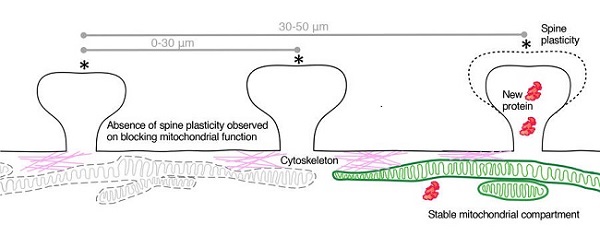News Archive
What fuels memory?
January 2019. In order to respond both swiftly and appropriately to impulses, brain cells (“neurons”) need to have proteins directly at hand, i.e. not only in the cell body, but also in their processes: the axons, dendrites and synapses, where information transfer occurs between neurons. In order to translate proteins locally, the precursors (messengerRNAs) and machinery (ribosomes), as well as the fuel need to be close by and freely available. Researchers at the Max Planck Institute for Brain Research have used high-resolution imaging techniques to track mitochondria, the cell’s power plants, in dendrites. They found that mitochondria are positioned within dendrites to serve a local neighborhood of synapses. Furthermore, they showed that these organelles are not only the main energy source for local translation, but are also essential for synaptic plasticity - a mechanism important for memory formation. These findings are published in the new issue of the journal Cell.
Although the brain occupies about two percent of the human body, it consumes twenty percent of the energy produced. The primary energy fuel is glucose, which is oxidized via glycolysis in the cytoplasm and oxidative phosphorylation in mitochondria to generate ATP. In neurons, mitochondria are abundant in all parts of the cell, including in the presynaptic terminals, where the neurotransmitters are released, and in the dendrites.
“Protein synthesis in dendrites is an important source of protein for synapses yet very little is known about the link between energy supply and the dendritic synthesis of proteins.”, Max Planck Director Erin Schuman says. Together with her colleagues Vidhya Rangaraju and Marcel Lauterbach, she reports that spatially stable mitochondrial compartments fuel dendritic translation during synaptic plasticity in an activity-dependent manner. By using super-resolution microscopy, they were not only able to visualize the mitochondria in dendrites, but also monitor their movement over time. Schuman: “Dendritic mitochondria are surprisingly stable. They are anchored via the cytoskeleton and can even remain in place for over an hour”.
In addition, the researchers used an optical technique to disable a mitochondrial compartment with light and show that locally stabilized individual mitochondrial compartments indeed provide the energy supply for local protein synthesis. “It has been understood previously that the translational machinery required to carry out local protein synthesis is compartmentalized in dendrites, in addition, here we show that the energy source to fuel local protein synthesis is also compartmentalized” Rangaraju adds. Blocking the local function of mitochondria even prevented the structural neuronal changes associated with synaptic plasticity. “Local mitochondria are essential for brain plasticity, like that associated with learning and memory.
These findings are not only interesting for fundamental research, but might also shed new light on mitochondrial dysfunction associated with many neurodegenerative diseases.”, Schuman says.

Figure: Mitochondrial compartments (green mitochondria) are temporally and spatially stabilized in dendrites by cytoskeletal anchoring (pink actin filaments) and serve as local energy sources for local protein synthesis when spines are stimulated (*) to induce spine plasticity (red proteins, enlarged spine). However, local perturbation of mitochondrial function with light (gray mitochondria) abolished spine plasticity in neighboring spines (within 0-30 microns) and not in remote spines (30-50 microns).
Publication:
Rangaraju, V., Lauterbach, M. and Schuman, E.M. (2019). Spatially restricted mitochondria fuel the extensive local protein synthesis needed to support synaptic plasticity. Cell: in press. Link
Contact:
Public Relations, Max Planck Institute for Brain Research, Max-von-Laue-Str. 4, Riedberg Campus, Frankfurt/Main, Germany, tel. +49 69 850033-2900 (Arjan Vink), pr@brain.mpg.de, www.brain.mpg.de, Link

